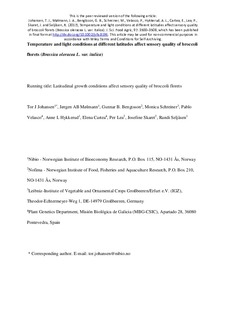Temperature and light conditions at different latitudes affect sensory quality of broccoli florets (Brassica oleracea L. var. italica)
Johansen, Tor Jacob; Mølmann, Jørgen; Bengtsson, Gunnar; Schreiner, Monica; Velasco, Pablo; Hykkerud, Anne Linn; Cartea, Elena; Lea, Per; Skaret, Josefine; Seljåsen, Randi
Peer reviewed, Journal article
Accepted version
Permanent lenke
http://hdl.handle.net/11250/2490635Utgivelsesdato
2017Metadata
Vis full innførselSamlinger
- Artikler / Articles [1419]
- Publikasjoner fra CRIStin [2481]
Originalversjon
Journal of the Science of Food and Agriculture. 2017, 97 (11), 3500-3508. 10.1002/jsfa.8196Sammendrag
BACKGROUND Broccoli (Brassica oleracea L. var. italica) is a popular vegetable grown at a wide range of latitudes. Plants were grown in 2009–2011 in pots with standardized soil, irrigation and nutrient supply under natural temperature and light conditions at four locations (42–70° N). A descriptive sensory analysis of broccoli florets was performed by a trained panel to examine any differences along the latitudinal gradient for 30 attributes within appearance, odour, taste/flavour and texture. RESULTS Average results over three summer seasons in Germany, southern Norway and northern Norway showed that the northernmost location with low temperatures and long days had highest scores for bud coarseness and uniform colour, while broccoli from the German location, with high temperatures and shorter days, had highest intensity of colour hue, whiteness, bitter taste, cabbage flavour, stale flavour and watery flavour. Results from two autumn seasons at the fourth location (42° N, Spain), with low temperatures and short days, tended toward results from the two northernmost locations, with an exception for most texture attributes. CONCLUSION Results clearly demonstrate that temperature and light conditions related to latitude and season affect the sensory quality of broccoli florets. Results may be used in marketing special quality regional or seasonal products. © 2016 Society of Chemical Industry
